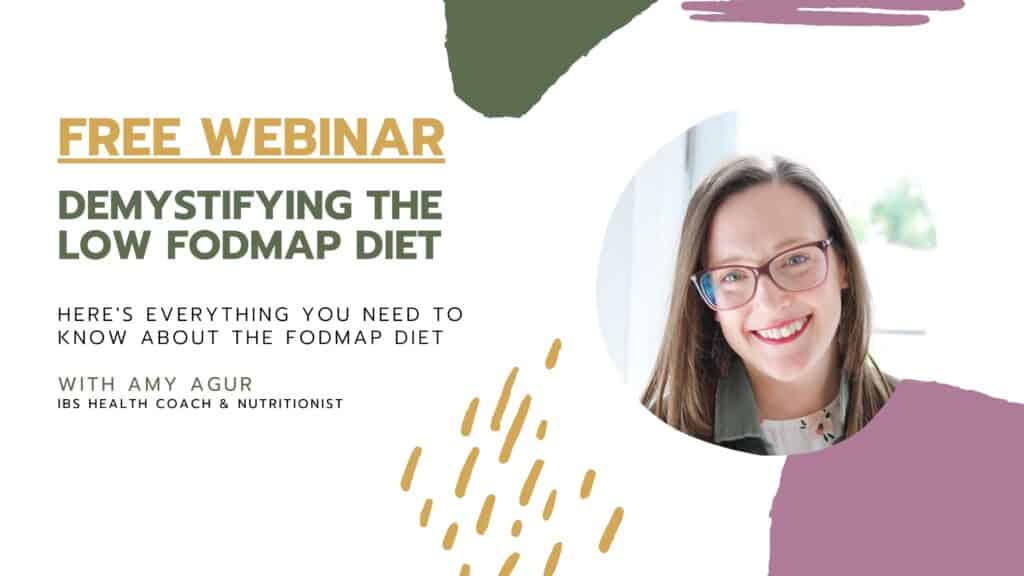Did you know 3 out of 4 IBS patients can control their daily symptoms with the Low FODMAP Diet? While it doesn’t work for everyone, many people are able to regain some control over their lives using this program. So what is the Low FODMAP Diet, and how does it work?

The Low FODMAP diet, developed by Monash University in 2005, is a short-term program that helps IBS patients test common dietary triggers.
The program is done in three phases: elimination, re-challenge, and reintegration. The end goal is a designer Low FODMAP Diet tailored to your personal sensitivities. Any high FODMAP foods you can tolerate will be added back to your long-term diet.
Before you begin reading, make sure to check out my previous article What is a FODMAP to make sure you understand what you’re testing.
Phase One: Elimination
During this phase, all high FODMAP foods are removed from your diet for 2-6 weeks. Removing high FODMAP triggers should reduce or relieve your IBS symptoms within one month (4 weeks).
Make sure you follow the elimination diet strictly, or you won’t get the results you need. You should also consider external triggers like stress in your personal life, sleep quality, and any other health concerns that may trigger IBS symptoms and skew your results.
Use this time to figure out what your “normal” is. If you have been suffering from severe symptoms for a long time, you may have forgotten what a normal bowel movement looks like. Keep a diary of what goes in and what comes out of your body during this phase. This will help you describe your symptoms to your health care team, and give you a better picture of your baseline symptoms. This information will come in handy when you enter phase two.
If you need help starting a symptom diary, check out this article.

Phase Two: Re-Challenge
In the second phase, each FODMAP group is tested one at a time. During this period, you continue to follow the elimination diet, but add one test food in increasing amounts over three days. Once you’re finished testing a food, you return to the elimination diet proper for a “washout” period. This will relieve any symptoms triggered by the test group so you can start your next challenge with a clean slate. Check out my article on How To Complete The Re-Challenge Phase for more specific instructions.
The re-challenge phase is normally completed in 4-6 weeks depending on the number of groups you’re testing. For example, if you know you are lactose intolerant before you begin the elimination phase, you won’t need to test this group again.
It’s really important to keep a diary of what you eat and any symptoms you experience during this phase in particular. This will help both you and your dietitian decide what foods you can eat long-term. Keeping a record of your symptoms will also give you important information about how your body reacts to each FODMAP group.
Phase Three: Personalization
During the reintroduction phase, individual foods from each FODMAP group are added to your long-term diet. You don’t have to return to the elimination phase after testing these. If you don’t experience symptoms, you can keep each food in your diet going forward.
It’s normally recommended that patients start with a group they handled well and move toward groups they had issues with. You can also start with foods you miss, or that would make your life a little easier. For example, lots of people start with bread or pasta, even if Fructans gave them trouble.
Tests in this phase are normally done using an average portion. This process is much faster than phase two, as foods are tested by alternating test days and rest days. If the food you’re testing causes symptoms or if you’re testing food from a group that caused you trouble in phase two, you can always start with a smaller portion.
Any group that caused severe symptoms in phase two should be discussed with your dietitian before reintroduction. They can make recommendations for foods you may be able to tolerate from that group and let you know if there are specific foods you should avoid long-term.
Maintenance Phase
Over time your dietary needs may change. For example, our bodies produce less lactase – the enzyme that breaks down lactose – as we age. This means your sensitivity to lactose may change as you grow older. You may also find that you can add items over time. Because of this, it’s in your best interest to re-test groups periodically to check for changes.
You may also experience periods in your life when the long-term diet you’ve settled on isn’t working. This can happen for several reasons: 1) Your portions may have increased over time. 2) You may be suffering from excessive stress or lack of sleep; both of which can decrease your tolerance for FODMAPs. 3) Your tolerance to a specific FODMAP group may have changed over time and need to be reassessed.
If you are experiencing symptoms after a period of relief, first, check the labels on items you eat regularly. Companies don’t always advertise when they change the ingredients in their products. Because of this, you may have added some FODMAPs to your diet without knowing.
You may also need to address external factors like your current stress level, your sleep hygiene, your physical health, etc. Try getting some extra sleep, delegating some tasks at home or at work, and finding some time to be nice to your body.
If you can’t pinpoint the issue, go back to the elimination diet until you feel better. If that doesn’t relieve your symptoms, you might consider a trip to your doctor as something else may be mimicking IBS symptoms and require your attention.

Final Thoughts
Now that you understand the three phases of the Low FODMAP Diet, I hope you it give a try. Don’t let the elimination phase scare you. It’s only 2-6 weeks, and there are lots of delicious low FODMAP recipes available here at The FODMAP Formula and online, as well as your local bookstore.
You might also like one of these:
- When Should You Start the Low FODMAP Diet Wondering if you should start the Low FODMAP Diet? Check out this article to find out if the low FODMAP program is right for you and a few things you should try first. x
- How Long Does It Take for the Low FODMAP Diet to Work? Wondering how long it takes to see changes on the low FODMAP diet? Like most things about IBS, the answer is… complicated.
- How to Relieve Trapped Gas Need some help letting it go? These practical tips will help you prevent trapped gas when you can and relieve it when it strikes.
If you like this post, don’t forget to share it! Together we’ll get the low FODMAP diet down to a science!

